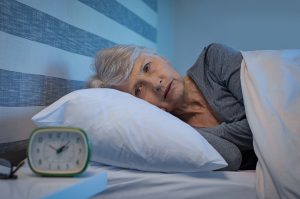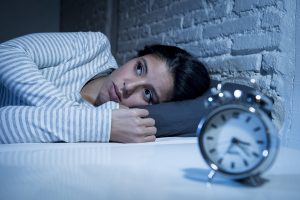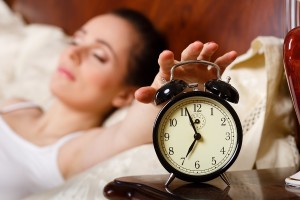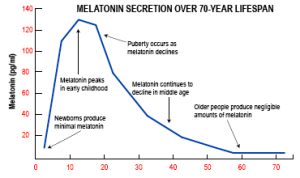You are not alone when you are sleepless. Insomnia is a widespread problem in society.
Previous review of the topic of insomnia
I have reviewed the topic of insomnia before in a blog.
Briefly I pointed out that in some people there is a mutation of the gene that controls the circadian sleep rhythm. It is called the CRY1mutation. Some people have sleep disturbances from working night shifts. I mentioned the blue light of electronics that is produced by the TV screens or computer screens. The more you are exposed to it, the more it stimulates the brain to produce serotonin. This undermines the melatonin production, and as a result the person finds it extremely difficult to fall asleep. Children playing with i-phones, tablets or watching children’s programs on television can have sleep disturbances from the blue light. Blue has the frequency that over stimulates the brain and interferes with melatonin production. Drug and alcohol abuse can also interfere with the normal circadian sleep rhythm and cause insomnia.
Hormone factors of insomnia
For natural sleep to occur, we need melatonin which the pineal gland releases in the evening. It initiates and maintains sleep during the night. The natural opponent of melatonin is cortisol, the stress hormone, from the adrenal glands. Both hormones need to be in balance to allow you to sleep normally. Shortly before we wake up in the morning melatonin production goes down and cortisol production is up. Cortisol levels are low at night and high during the day. So it is cortisol that keeps us going throughout the day. But an excess of cortisol from chronic stress can also interfere with falling asleep and sleeping through the night.
Stress and insomnia
When we feel stressed, cortisol production goes way up. This has consequences regarding our sleep pattern. It can interfere with falling asleep, causes us to wake up from a deep sleep in the middle of the night and can give us problems falling asleep again. Chronic stress exposure leads to high cortisol production by the adrenal glands, which in turn will lower melatonin and cause sleep disturbances. Older people (above the age of 50) have very little melatonin production left, as there is an age-related decline of melatonin production. The melatonin production is highest in younger years and lowest in older age.
What to do when you are sleepless
There are several over-the-counter remedies, which in combination can be quite effective.
Melatonin for when you are sleepless
Melatonin (3 mg at bedtime) is a good start to see what it does for your sleeplessness. Taking a small amount of melatonin at bedtime we can re-establish the balance between cortisol and melatonin, which helps the circadian hormone rhythm and sleep pattern to come back. Some people wake up in the middle of the night and find it difficult to fall asleep again. If this happens at 3 AM, a good remedy at this time is to take another 3 mg of melatonin. Melatonin stays in the system for about 4 hours. Light during the day de-activates the effect, when light hits the retinas upon opening your eyes. You should not exceed 6 mg of total melatonin overnight. Otherwise it will interfere with the balance of cortisol and melatonin, lowering cortisol levels, which would rob you of energy during the day.
Phosphorylated serine (Seriphos)
A supplement that is freely available in the US (but not in Canada) consists of a simple amino acid. As this link shows (second item in the link) phosphorylated serine Seriphos) helps to down-regulate cortisol levels (lowering them). This means that melatonin gets the upper hand and you can sleep again.
The dosage for phosphorylated serine (Seriphos) varies from person to person, but will be in the range of 1000 mg to 3000 mg in the evening. After about 30 days the circadian rhythm may have recovered and you can stop the Seriphos. A one-day pause is required once a month for resetting the hormone receptors. Should you still have problems sleeping, you can continue with it for another month and pause again for a day. Seriphos has very few side effects.
Valerian root capsules
Another useful sleep aid is valerian root (as capsules). 500 mg to 1000 mg will help you to relax. It does not have the side effect of feeling groggy the next morning.
Other considerations when you are sleepless
Hormone problems like thyroid abnormalities (too much or too little thyroid hormones) are issues that your doctor has to investigate. Women in menopause often have sleep disturbances due to a lack of estrogen and progesterone. A knowledgeable healthcare professional is able to take care of that by prescribing bioidentical hormone creams.
When men approach andropause (the equivalent of menopause in women), they lose testosterone production. This can cause insomnia. The doctor can verify the hormone loss by a blood test. Replacement with either bioidentical testosterone cream or injections will rebalance testosterone levels. Insomnia may disappear. It is essential not to overdose testosterone, as this can also cause insomnia.
Sleep lab for when you are sleepless
When home remedies do not help, it may be time to check into one of the sleep labs to diagnose the kind of sleep disorder you are suffering from. Here is an overview what is happening there.
Essentially you get hooked up to monitors and are encouraged to just sleep as you would normally do. The physician in charge of the lab will later explain to you what the monitors showed, and tell you what type of sleep. According to the findings your doctor will recommend what measures are appropriate to remedy the situation.
Treatment for insomnia when over-the-counter remedies fail
Short acting benzodiazepams
When anxiety is not a problem, but only insomnia is (falling asleep or staying asleep) lorazepam 1 mg (Ativan) or temazepam 10 mg (Restoril) are shorter acting benzodiazepams that will help. It is not a permanent but a short “emergency break” for intermittent use, so that the GABA benzodiazepine receptors have time to recover. Otherwise, with continuous use tolerance would set in. This means higher and higher doses of the sleep medication would be necessary to achieve the same effect. Another non-benzodiazepine is Zolpidem 5 mg (Ambien). Even though this medication is not a benzodiazepine, it works on stimulating the same GABA benzodiazepine receptors.
Longer acting benzodiazepams combined with antidepressant Trazodone
For several years the combination of a small amount of the longer acting benzodiazepams, clonazepam (Rivotril) at 0.5 mg combined with a small amount of the anti-depressant trazodone (Oleptro or Desyrel) at 50 mg at bedtime has been has been in use quite successfully.
But there is a concern of drowsiness caused by Rivotril as this link shows.
Trazodone, which is an antidepressant has a sleep cycle restoring effect at low doses and has less side effects, because it is used at ¼ the dose for a full-blown depression. Males are often complaining that it reduces their sex drive, and it may cause erectile dysfunction.
Clonazepam side effects
Rivotril was originally in use to control epileptic seizures and anxiety. The combination therapy for sleep disorders uses Rivotril at ¼ of the regular dose. Although it is good as a sleep aid, it has a long half-life and stays in the system well into the next day. This may present as sleepiness and cause falls in elderly patients because of clouded attention. Replacement by one of the medium long acting benzodiazepams could be the solution. A drug pause for 1 day will help to reset the GABA benzodiazepine receptors and prevent tolerance from happening. Knowing all those effects and side effects it is wiser to reserve the use of these medication strictly when everything else has failed!
Conclusion
As I mentioned before, you are not alone when you are sleepless. Insomnia can present as having problems to fall asleep, but it may present in others as a problem in the middle of the night waking up and having problems going back to sleep again.
I described non-conventional methods to help you to sleep using melatonin, Seriphos and valerian root capsules. If this fails, a sleep lab investigation may be necessary to get to the bottom of your insomnia problem. Physicians often prescribe short acting benzodiazepams like lorazepam (Ativan) and temazepam 10 mg (Restoril).
Other possibilities to treat insomnia
There are other possibilities to treat insomnia, with a combination of a low-dose antidepressant (trazodone, brand name Oleptro in the US) and low-dose anti-seizure and anti-anxiety drug clonazepam (Klonopin or Rivotril). Anxiety can often be a big component in insomnia and this treats both. On the other hand, anxiety is a separate problem, which needs professional treatment. There can be side effects of sleepiness from clonazepam and men complain of a lack of sex drive and erectile dysfunction from trazodone. Help is available when you are sleepless. But you need professional help to work on the problem and find the solution.















